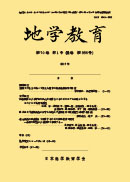Volume 70, Issue 1
Displaying 1-7 of 7 articles from this issue
- |<
- <
- 1
- >
- >|
Original Article
-
Development of a Simple Device Observing Sounds of Rain for Recognizing Differences in Raindrop Size2017 Volume 70 Issue 1 Pages 1-13
Published: July 28, 2017
Released on J-STAGE: August 24, 2018
Download PDF (1338K)
Technical Article
-
2017 Volume 70 Issue 1 Pages 15-22
Published: July 28, 2017
Released on J-STAGE: August 24, 2018
Download PDF (876K) -
2017 Volume 70 Issue 1 Pages 23-29
Published: July 28, 2017
Released on J-STAGE: August 24, 2018
Download PDF (728K) -
2017 Volume 70 Issue 1 Pages 31-41
Published: July 28, 2017
Released on J-STAGE: August 24, 2018
Download PDF (1976K)
Book Review
-
2017 Volume 70 Issue 1 Pages 43
Published: July 28, 2017
Released on J-STAGE: August 24, 2018
Download PDF (193K)
News
-
2017 Volume 70 Issue 1 Pages 45-46
Published: July 28, 2017
Released on J-STAGE: August 24, 2018
Download PDF (976K)
Proceeding of the Society
-
2017 Volume 70 Issue 1 Pages 47-62
Published: July 28, 2017
Released on J-STAGE: August 24, 2018
Download PDF (901K)
- |<
- <
- 1
- >
- >|
